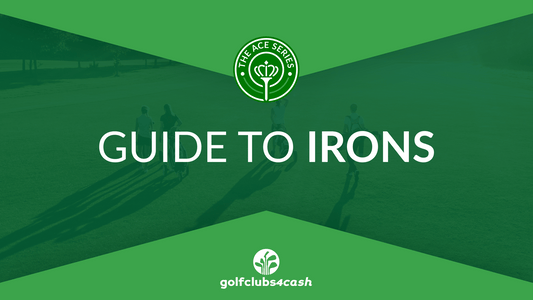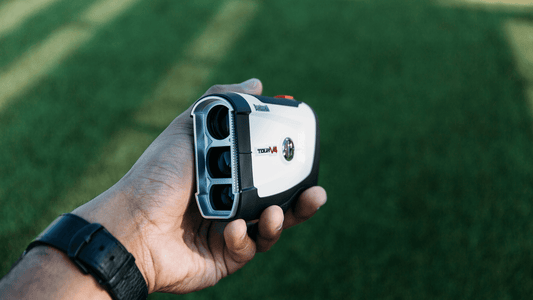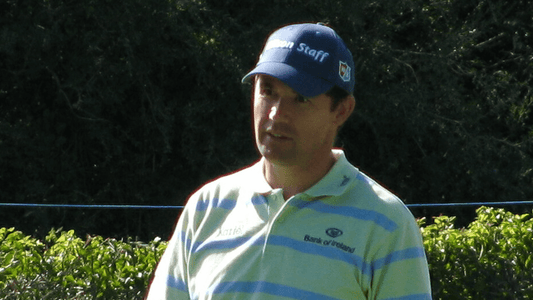
Our guide to the rules of golf
Whether you’re a beginner to the game of golf or you’ve been playing for some time, it’s important to be up to speed on the latest rules or you might find yourself in hot water. So, as well as polishing up your golf clubs and accessories, be sure to polish up on the rules, too.
For beginners in golf, understanding the rules can be overwhelming and you don’t want to embarrass yourself on the course by not fully understanding what’s allowed and what’s not. And for those more experienced in the game, it’s helpful to brush up on your existing knowledge and make sure you are up to date with any of the latest changes.
In this article, we’re going to take you through the basic rules of golf to help you build your confidence, enjoy your round and take your game to new heights. We have fact-checked everything against the R&A’s official website, but as a small disclaimer things can change quickly, so make it a priority to consult the R&A’s rules regularly to make sure you’re working from the latest legislation. Please also note that these rules relate to golf played in the UK, so if you’re playing further afield make sure you understand any differences in legislation.
If you are in doubt about any situation, please check with the R&A to be sure. And you can download the R&A Golf Rules app so you’ve always got a copy in your pocket!
Be a good playing companion
Playing in the spirit of the game and being honest is the most important consideration on the course. Show consideration to others by helping to look out for their (and your) safety, and playing at an acceptable speed so you don’t hold people up. Take care of the course you’re playing on, too, and leave it in good shape for the next golfers to use it by smoothing bunkers, replacing divots and repairing ball marks on putting greens etc.
Take your shoot in an average of no more than 40 seconds. The strict rule is that whoever’s ball is furthest from the hole should normally play first, but if it’s possible to do so then prioritise ‘ready golf’ where you can play out of turn if it’s safe and helps speed up the game.

The golf course
It’s important to know what part of the course your ball is lying on, as it may affect what you can and can’t do in that situation.
It’s important to know what part of the course your ball is lying on, as it may affect what you can and can’t do in that situation.
Preparing to play
Before you start your round, make sure you have consulted any local rules that are specific to the course that you’re playing. You’ll usually find them on a noticeboard, on the scorecard and the golf club’s website.
Next, establish which tees you are supposed to play from (they’re usually colour-coded and sometimes you can choose your own). Arrive at the first tee in advance of your tee time and make sure you don’t have more than 14 clubs in your golf bag. You can find out more about this in our article about the three most important golf clubs to carry. Add a mark to your ball so that you’re able to identify it throughout your game.
Starting a hole
When you’re starting a hole, you’re doing so from the teeing area, defined by two tee markers. It’s a rectangular area, measured by two club lengths from front to back, and you’ll usually use your driver for this shot. You are only allowed to play your ball from a tee when you’re in this teeing area - anywhere else it’s not permitted to use a tee.
Before hitting your ball you can take practice swings (a ‘practise swing’ is defined as a swing without the intent to hit the ball), but avoid taking too many or you’ll slow down play. If you want to work on your swing, the course is not the place to do it - check out our top tips for improving your golf swing and spend time on the driving range honing your technique. You’re allowed to touch the ground with your clubhead when you hit the ball, in fact sometimes it’s unavoidable, but don’t damage the course and be sure to replace any divots you create.
Be aware that there are some rules which are specific to bunkers. If your ball is in a bunker, you aren’t allowed to touch the sand in practice swings. And when playing a ball you’re allowed to touch the ground behind the ball lightly with your club, but when it’s in a bunker you’re not allowed to touch the sand behind the ball!


Taylormade R7 CGB Max Driver / 10.5 Degree / Regular Flex Taylormade Reax 45


Taylormade R7 Draw Driver / 10.5 Degree / Regular Flex Taylormade Reax 55 Shaft


Taylormade R7 Draw Driver / 10.5 Degree / Regular Flex Taylormade Reax 55 Shaft


Taylormade R7 CGB Max Driver / 10.5 Degree / Senior Flex Taylormade Reax 45


Taylormade RBZ Driver / 10.5 Degree / Regular Flex Matrix Ozik Xcon-5


Taylormade M2 2017 Driver / 10.5 Degree / Regular Fkex Fujikura XLR8 Pro 56


Taylormade R7 Superquad Driver / 9.5 Degree / Stiff Flex Fujikura Reax 65 Shaft


Taylormade M1 2017 Driver / 9.5 Degree / X-Flex Tour AD TP-6 Shaft
Playing the ball
Strike the ball with the head of your club. If you miss, that still counts as a ‘stroke’ - you can’t call it a practise swing as you had the intention of hitting the ball (the definition of a stroke is ‘the forward movement of the club with the intention of hitting the ball’. If you hit the ball more than once during the stroke it only counts as one shot. After playing your ball from the teeing area, you then play it from where it lands (‘playing the ball as it lies’), aiming to get it closer to the hole on each shot.
You aren’t allowed to improve or alter the situation around your ball - for example, if your ball lands in long grass that might mean a difficult lie, or trees that might make it difficult to get in to play the ball. This is called ‘playing the course as you find it’ - wherever your ball lands you must accept the conditions that might affect your shot.

When you can and can’t touch your ball
Once you’ve played your ball from the tee, you won’t touch it again with anything other than your club until it’s on the putting green. When you’re there, you can lift it, clean it and mark its position with an object like a ball marker or coin. If you lift your ball it has to be put back on the exact spot that it came from.
Finishing a hole
When you’re at the green and near the hole, it’s time to get your putter out. When your ball is in the hole and all of it is below the putting green, you’ve finished the hole (this is sometimes called ‘holing out’). Sometimes a flagstick can prevent the ball from falling completely into the hole, and in this case, as long as it is touching the flagstick and any part of the ball is below the surface of the putting green, it’s treated as being holed out. Check out our guide to perfecting your putting for more information on this.


Odyssey Works Versa 1 Putter / 34 Inch


Odyssey Ai-One Double Wide Putter / 35 Inch


Odyssey White Hot OG Putter 7S 2021 / 35 Inch


PXG Closer Battle Ready II Putter / 34.5 Inch


Scotty Cameron Phantom X 11 2021 / 34 Inch


Ping Heppler Fetch Putter / 35 Inch


Scotty Cameron Phantom X 5.5 2022 Putter / 34 Inch


Cobra King Vintage Cuda Putter / 34.5 Inch
Free relief and penalty relief
Sometimes, there are situations where you don’t have to play the ball as it lies because something that is not meant to be part of the challenge has interfered with the shot - for example, a cart path, or temporary water. In these cases you can move your ball without penalty by dropping it away from the obstruction nut no nearer the hole - sometimes called a ‘drop shot’). This is called ‘free relief’.
Sometimes you hit your ball into a place you don’t want it to go (like a bush, or a pond) and you’re unable to play the ball as it lies. If this happens, you’ll need to take a penalty relief and this usually means a penalty of one stroke.
Losing a ball or hitting it out of bounds
You have three minutes to search for your ball, and if it hasn’t been spotted within that time it’s classed as ‘lost’. This way, it doesn’t hold up the game too much (you could be looking for a very long time!). It’s out of bounds if it comes to rest outside the course boundary. In either case, you have to take a form of penalty relief called ‘stroking distance relief’, adding one stroke to your score, going back to your last playing shot and playing your next shot from there.
Unplayable balls and lateral relief
If you think you can’t play your ball as it lies, e.g. in a bush, you can take a form of penalty relief known as ‘unplayable ball relief’ for one penalty stroke. This brings three options - either taking ‘stroking distance relief’ by playing from where you played your last stroke, you could drop back on the line as far as you like by keeping the spot where your ball lay between you and the hole, or you could drop within two club lengths of where your ball lay - but no nearer the hole (this is called ‘lateral relief’). The only place on the course where you can’t use unplayable ball relief is when the ball is in a penalty area.
Penalty areas
Penalty areas often contain water - e.g. ponds and streams. There are two types of penalty areas, defined as either red or yellow. If you find your ball in a penalty area you can play it as it lies if you want to or are able to, or take a one-stroke penalty and take relief outside the penalty area. Whether your ball last crossed the boundary of a red or a yellow penalty area affects the options you have for taking relief. If it last crossed a yellow penalty area, for one penalty stroke you can either go back to where you played your last stroke, or go back on the line keeping the point where the ball last crossed the edge of the penalty area between you and the hole. If your ball last crossed the edge of a red penalty area you have an additional third option - again for a penalty stroke. This allows you to take lateral relief by dropping the ball two club lengths of where your ball last crossed the edge of the penalty area - no nearer the hole. If you don’t find your ball but are sure that it’s in the penalty area you can still take relief outside the penalty area for one penalty stroke.
Finishing a round
At the end of your round, be sure to thank your playing partners. If you’ve been keeping score, make sure it’s completed properly, signed by you and your marker and returned to the competition organiser. You can usually also post a score electronically - do this as soon as possible. If you’ve been playing a match as part of a competition, post your match result on the noticeboard and tell the organisers. Keeping track of your scores is also important for keeping your playing handicap up to date.
We hope that brushing up on and understanding these fundamental rules of golf will help you play with more confidence. Now, go out and enjoy!
For any questions you’ve got, our experts are here to assist. Get in touch today and let us know how we can help. And don’t forget to download the golfclubs4cash app so you’ve got quick access to all our latest second hand golf equipment deals!




